City of Light
Friday 21 January – Sunday 23
January 2000
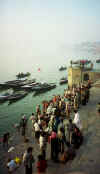 Having endured several long,
dusty journeys on local buses, crammed into two-person seats with at least one
other body for several hours at a time, we decided to upgrade our mode of
transport and fly from Khajuraho to our next stop, Varanasi.
Situated on the western bank of the sacred Ganges and dedicated to the
god Shiva, this is one of the holiest places in the whole of India.
Having endured several long,
dusty journeys on local buses, crammed into two-person seats with at least one
other body for several hours at a time, we decided to upgrade our mode of
transport and fly from Khajuraho to our next stop, Varanasi.
Situated on the western bank of the sacred Ganges and dedicated to the
god Shiva, this is one of the holiest places in the whole of India.
It is also, as we were to find
out, one of the dirtiest, but numbed by the constant contact with filth and
decay wherever we ventured in the country, we were not about to be put off and
were both looking forward to visiting this magical place.
We had read up in the guidebook on the potential dangers and annoyances
we might face, ranging from power cuts and predatory rickshaw-wallahs to food
poisoning, touts and theft. In
addition, the Ganges is far from clean. The
latest faecal coliform count was measured at 250,000 times the World Health
Organization's safe permitted maximum, so we were not risking any chai (tea) from
people who might have been rinsing their glasses out in the river!
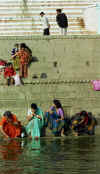 The main attraction in Varanasi
is the long string of ghats that line the western bank of the Ganges.
Most are used for bathing, and Hindu pilgrims come here to bathe in the
waters, a ritual that washes away all their sins.
Others are used for burning and the bodies of people who die in this
auspicious place are cremated, ensuring them release from the cycle of rebirths
(a sort of passport to heaven).
It was a strange sensation watching the rituals of life and death played
out so openly in the public domain, but it was also this accessibility to such
ancient traditions that captivated our attention and encouraged us to learn
more.
The main attraction in Varanasi
is the long string of ghats that line the western bank of the Ganges.
Most are used for bathing, and Hindu pilgrims come here to bathe in the
waters, a ritual that washes away all their sins.
Others are used for burning and the bodies of people who die in this
auspicious place are cremated, ensuring them release from the cycle of rebirths
(a sort of passport to heaven).
It was a strange sensation watching the rituals of life and death played
out so openly in the public domain, but it was also this accessibility to such
ancient traditions that captivated our attention and encouraged us to learn
more.
We had heard that the most
interesting time to visit the ghats was at dawn, when the river is bathed in a
magical light and pilgrims come to perform puja to the rising sun.
With over 100 ghats along the length of the river, these rituals could be
witnessed from many spots and the best way to take
it all in was out on the water in a boat. Boat
trips up along the riverbank have become a pretty tacky must-do tourist ritual
and even at dawn, there were several 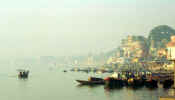 boats out on the
water; but despite this, it presented a poignant, unforgettable scene.
All along the riverbank, throngs of people gathered for a
ritual bath, practised yoga, offered blessings, cast flowers, shaved, swam, or
threw money to the ever-present beggars in a bid to
improve their karma.
boats out on the
water; but despite this, it presented a poignant, unforgettable scene.
All along the riverbank, throngs of people gathered for a
ritual bath, practised yoga, offered blessings, cast flowers, shaved, swam, or
threw money to the ever-present beggars in a bid to
improve their karma.
Every now and again, something
would hit against the side of the boat or the oar would uncover what looked like
a parcel floating in the water, wrapped in cloth and bound with rope.
Intrigued as to what they could possibly be (most Indians would not be so
careful in packaging their rubbish) we asked our boatmen what they were.
“Bodies”, he replied. As
animals, children and adults who died of diseases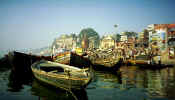 could not be cremated in the
Hindu religion, they would apparently be bundled up and set off to float down
river instead. Usually, they would
be weighed down with stones, but every now and again they would bob to the
surface and could be seen making their way downstream.
Once we were conscious of what these packages actually were, we seemed to
see them everywhere and were doubly resolved not to go anywhere near the water.
could not be cremated in the
Hindu religion, they would apparently be bundled up and set off to float down
river instead. Usually, they would
be weighed down with stones, but every now and again they would bob to the
surface and could be seen making their way downstream.
Once we were conscious of what these packages actually were, we seemed to
see them everywhere and were doubly resolved not to go anywhere near the water.
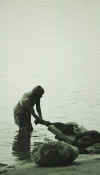 One familiar sight at many of
the ghats was the burgeoning laundry business undertaken by dhobi-wallahs of
all ages. Using soap, scrubbing
brushes and a stone, clothing would be scrubbed and then beaten clean, using the
repellant (but holy) water of the Ganges for the rinse cycle. Vast stretches of the riverbank were turned over to clothes
drying. Having washed all our
clothes in the bathtub on our travels to date, we were somewhat intrigued to
know
One familiar sight at many of
the ghats was the burgeoning laundry business undertaken by dhobi-wallahs of
all ages. Using soap, scrubbing
brushes and a stone, clothing would be scrubbed and then beaten clean, using the
repellant (but holy) water of the Ganges for the rinse cycle. Vast stretches of the riverbank were turned over to clothes
drying. Having washed all our
clothes in the bathtub on our travels to date, we were somewhat intrigued to
know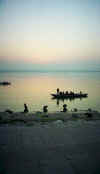 how clean they
would come back, but on second thought, decided not to
investigate the matter further; if they didn’t come back contaminated, they
would probably be in shreds not having withstood the intense thrashing to which
they would have been subjected.
how clean they
would come back, but on second thought, decided not to
investigate the matter further; if they didn’t come back contaminated, they
would probably be in shreds not having withstood the intense thrashing to which
they would have been subjected.
As morbid as it may sound, one
of the most fascinating things to watch was the activity around the Manikarnika
Ghat, the oldest and most sacred ghat, which was also the main burning
ghat in
Varanasi and one of the most auspicious places a Hindu can be cremated.
Corpses were lined up on bamboo stretchers alongside the area where
bodies were burning, swathed in white cloth (if they were men) or red or gold
cloth (if they were 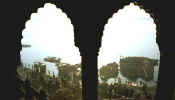 women). Male family members (absolutely no females were allowed in
this area) dressed in white could be seen giving orders to the outcasts who
handled the corpses and once the firewood had been purchased, they built the
fires, doused the body in the Ganges and then set it atop the wood pile and set
it alight. We watched the
proceedings from a high vantage point and every now and again as the wind
changed direction, would get a whiff of
women). Male family members (absolutely no females were allowed in
this area) dressed in white could be seen giving orders to the outcasts who
handled the corpses and once the firewood had been purchased, they built the
fires, doused the body in the Ganges and then set it atop the wood pile and set
it alight. We watched the
proceedings from a high vantage point and every now and again as the wind
changed direction, would get a whiff of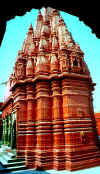 burning flesh.
It was eerie, but at the same time enthralling watching this incredible
ritual unfold in such a matter-of-fact way.
Interestingly, the bodies took ages to burn. Occasionally, the odd limb would fall out of the swaddling
and one of the doms (outcasts) would poke it back into the fire. When there were
nothing but ashes remaining, they would rake through the dirt, picking out any
pieces of jewelry or other valuables and then shovel the remains into the
Ganges, clearing the way for another fire and another body.
burning flesh.
It was eerie, but at the same time enthralling watching this incredible
ritual unfold in such a matter-of-fact way.
Interestingly, the bodies took ages to burn. Occasionally, the odd limb would fall out of the swaddling
and one of the doms (outcasts) would poke it back into the fire. When there were
nothing but ashes remaining, they would rake through the dirt, picking out any
pieces of jewelry or other valuables and then shovel the remains into the
Ganges, clearing the way for another fire and another body.
One other place we were keen to
visit whilst in Varanasi was the nearby town of Sarnath, where Buddha came to
preach his message of the 'Middle Way' to Nirvana after he achieved
enlightenment at Bodhgaya. Later,
magnificent stupas and monasteries were built here by the emperor Ashoka, but
were destroyed after Buddhism went
into decline and Muslim invaders destroyed and desecrated the city’s
buildings. It was thanks to the
British that Sarnath regained some of its former glory when archaeologists began
excavations in 1835, and it is now a major Buddhist centre.
Most of the monuments are set in
landscaped gardens and attract pilgrims from all parts of the world who come
here to worship Buddha. The main stupa, which dominates the site, is believed to mark the spot where the Buddha
preached his famous sermon. Pilgrims
walk around its perimeter clockwise chanting and praying, occasionally stopping
to kiss the ground before continuing on their journey around
the monument. We were interested to
see Tibetans forming part of this pilgrim contingent, as well as monks dressed in
the traditional orange robes we had seen throughout our travels in Southeast Asia.
But the ultimate oasis of
Varanasi for Pippa was the Bread of Life Bakery where she found a menu of
American Pancakes, Baked Potatoes and Tuna Sandwiches to assuage her
every-growing appetite and aversion to Indian food.
The very thought of the dishes she had grown to love at the beginning of
our travels sent her running for the bathroom and it had proved a challenge to
find anything that appealed to her palate in her ever-nauseous state.
With hindsight, it’s difficult to know what she remembers best about
Varanasi: the weird and wonderful scenes around the main ghats or the meals
at the Bread of Life Bakery.
Bodhgaya
Monday 24 January - Tuesday
25 January 2000
Now well into the story of
Buddha and following in his footsteps across India, no trip would have been
complete without a visit to Bodhgaya, one of the four most holy places in India
associated with Buddha and where he achieved enlightenment.
Rather than an archeological site, it is very much a working centre for
Buddhism and is the most important Buddhist pilgrimage site in the world.
Our journey to Bodhgaya was not
without incident. Setting the alarm
early for a 05.00am train from Varanasi (which eventually turned up well past
10.00am),
we seemed to spend most of the day stopping and starting for no apparent reason
and spending interminable hours sitting stationary on the tracks miles from any
station. In addition, there was no
option on travelling first class so we were bundled in like cattle (on second
thought, cattle are treated well in India), clinging to
our bags for fear they may not make it all the way and unable to find anything
resembling a toilet.
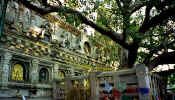 But we arrived safely and the
next morning were up early to walk to the temple and gardens and learn more
about Buddhism. Although Bodhgaya
is a relatively small place, it seems to be growing rapidly and, as the
guidebook most aptly put it, is acquiring all the usual tourism paraphernalia.
Some of this Pippa was not complaining about.
Having set off in search of something edible, she had happened upon
marmite (a British vegetable spread that she loves and Eric finds inedible) and
Dairy Milk chocolate (the best of British chocolate).
She had attained all the enlightenment she needed right there, but in the
spirit of things, took a look around the temples too.
But we arrived safely and the
next morning were up early to walk to the temple and gardens and learn more
about Buddhism. Although Bodhgaya
is a relatively small place, it seems to be growing rapidly and, as the
guidebook most aptly put it, is acquiring all the usual tourism paraphernalia.
Some of this Pippa was not complaining about.
Having set off in search of something edible, she had happened upon
marmite (a British vegetable spread that she loves and Eric finds inedible) and
Dairy Milk chocolate (the best of British chocolate).
She had attained all the enlightenment she needed right there, but in the
spirit of things, took a look around the temples too.
The Mahabodhi Temple stands
adjacent to a descendent of the original bodhi
tree under which Buddha attained enlightenment.
There are several stone
stupas dotted around the temple courtyard in which monks, pilgrims and
worshippers of all denominations meditate or pray.
It’s a beautiful, shady setting and flags and banners hang from the
trees, rustling in the breeze. There
was very little noise and the whole place seemed to have a calm aura about it
which invited us to sit and contemplate, presumably as Buddha did many
centuries before.